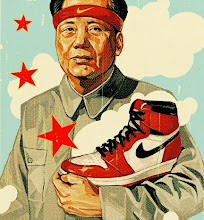In yesterday's WSJ article, Not Really 'Made in China', the author makes the point that the iphone, although thought of as ubiqutously American actually added almost 2 billion dollars to the US deficit with China last year.
Two academic researchers estimate that Apple Inc.'s iPhone—one of the best-selling U.S. technology products—actually added $1.9 billion to the U.S. trade deficit with China last year.Since the traditional trade deficit/surplus calculation counts the entire wholesale cost of the iphone as part of China's trade, there is a distorted view of the actual situation.
How is this possible? The researchers say traditional ways of measuring global trade produce the number but fail to reflect the complexities of global commerce where the design, manufacturing and assembly of products often involve several countries.
"A distorted picture" is the result, they say, one that exaggerates trade imbalances between nations.
Trade statistics in both countries consider the iPhone a Chinese export to the U.S., even though it is entirely designed and owned by a U.S. company, and is made largely of parts produced in several Asian and European countries. China's contribution is the last step—assembling and shipping the phones.
So the entire $178.96 estimated wholesale cost of the shipped phone is credited to China, even though the value of the work performed by the Chinese workers at Hon Hai Precision Industry Co. accounts for just 3.6%, or $6.50, of the total, the researchers calculated in a report published this month.
The vast majority of Chinese exports are made with various components that are first imported to China. Therefore, even if China implements currency exchange inform - the traditional view of US politicians, very little would actually change with respect to Chinese exports. Although components of cost will rise for Chinese manufactures (ie. labor, overhead), the costs of parts that are foreign imported actually decreases for the factory. This means that the final price is about the same as the price before the currency adjustment.
This means that the new currency policy would have little or no effect on the competitiveness of Chinese products wrt to American products. Although it would give China greater purchasing power for American goods, unless the US lowers export restrictions on high tech goods, exports wont increase much either.
This means that the new currency policy would have little or no effect on the competitiveness of Chinese products wrt to American products. Although it would give China greater purchasing power for American goods, unless the US lowers export restrictions on high tech goods, exports wont increase much either.
Although there are issues with current US/China trade, its important for Americans to better understand that its not a black and white cause of Chinese exchange rate policies. There needs to be better analysis of the fundamental problems with the US economy and less Chinese fear-mongering. Thank you, WSJ for helping out.

2 comments:
There is a lot of work to be done in re-setting the U.S./China trade relationship. The Chinese economy seems to be receding away from open markets to greater government control at the national, regional and local level as its trade surpluses grow.
US China trade imbalance
GPS robot [10x increase of the deposit sum]
I just finished a webinar with Mark and his partner, Antony, two days ago and it was GREAT.
During the webinar MARK and ANTONY shared their secrets to success and answered questions about their new version of the GPS Forex Robot that CAME OUT TODAY!
Post a Comment